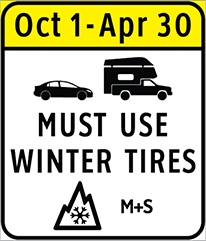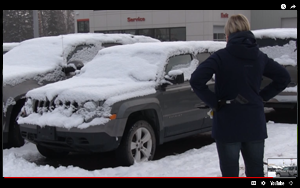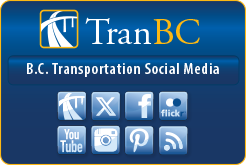Passenger Vehicle - Tire and Chain Requirements
Winter road conditions across most of B.C. often include snow and ice and most B.C. highways have high mountain passes where you are likely to encounter winter weather starting in October. It is the responsibility of the operator of a vehicle to understand the conditions on roads they regularly drive and equip their vehicle for those conditions.
About Winter Tires
What is a Legal Winter Tire in B.C.?
A legal winter tire (on a standard passenger vehicle or a four-wheel/all-wheel vehicle) MUST have at least 3.5 mm of tread depth.
A winter tire must be labelled with either of the following:
- The letters "M" and "S", the minimum legal requirement (mud + snow/all season tires)

- The 3-peaked mountain/snowflake symbol (some manufacturers label with both the mountain snowflake and the M+S symbol)

3-peaked mountain/snowflake tires (which include all-weather tires) offer better traction on snow and ice. We recommend drivers install 3-peaked mountain/snowflake tires for cold weather driving and, for extreme conditions, carry chains.
Summer tires are not permitted for driving during designated winter months. Chains on summer tires are not an acceptable substitute for legal winter tires on signed B.C. highways.
Chains, Traction Devices and Additional Safety
Matching Winter Tires
We recommend drivers use four winter tires that are evenly matched in tread type and depth; however, you must have at least two matching winter tires on the primary drive axle, even when driving a 4X4 vehicle. Mixing tires with different tread patterns, internal construction and size compromises stability, and should be avoided.
Air Pressure
Maintaining proper air pressure extends tread life and improves safety. Tire pressure decreases as temperatures drop, so check the pressure at least once a month when the tires are cold.
Types of Traction Devices
Passenger vehicles may use alternative traction devices with their winter tires. Only use these devices if they have been tested for performance in winter conditions.
Chains
When placed on a vehicle’s primary drive axle, steel link chains provide superior traction in snow and ice and will minimize slippage on a banked curve. Cable chains provide adequate traction, but lateral slippage may occur on banked curves.
Studded Tires
These tires may only be used on BC highways from October 1 to April 30 and the studs should not protrude more than 2 mm from the tread or traction surface of the tire. Use of studded tires outside of this period may result in a fine.
If you are using studded tires, you should have them on all four wheels for even traction. If using studded tires on the front of the vehicle they MUST be used on the back of the vehicle as well. Read the changes in the Act and the Regulations to get details on permissible studded tires.
Textile Tire Cover
A textile sheath placed over a winter tire improves traction in the same manner as steel tire chains. They work best on snow and ice. When used on asphalt they will quickly degrade.





